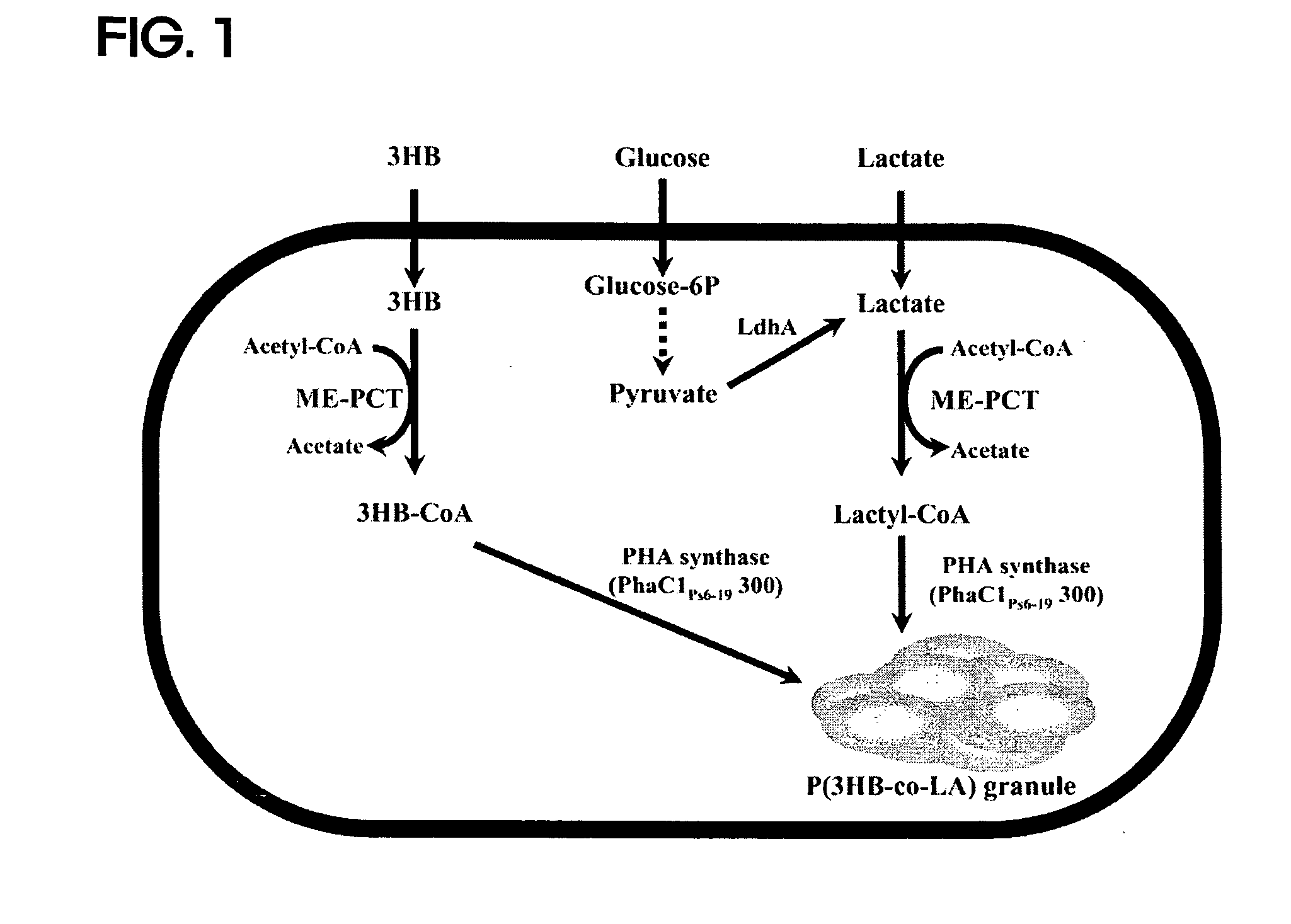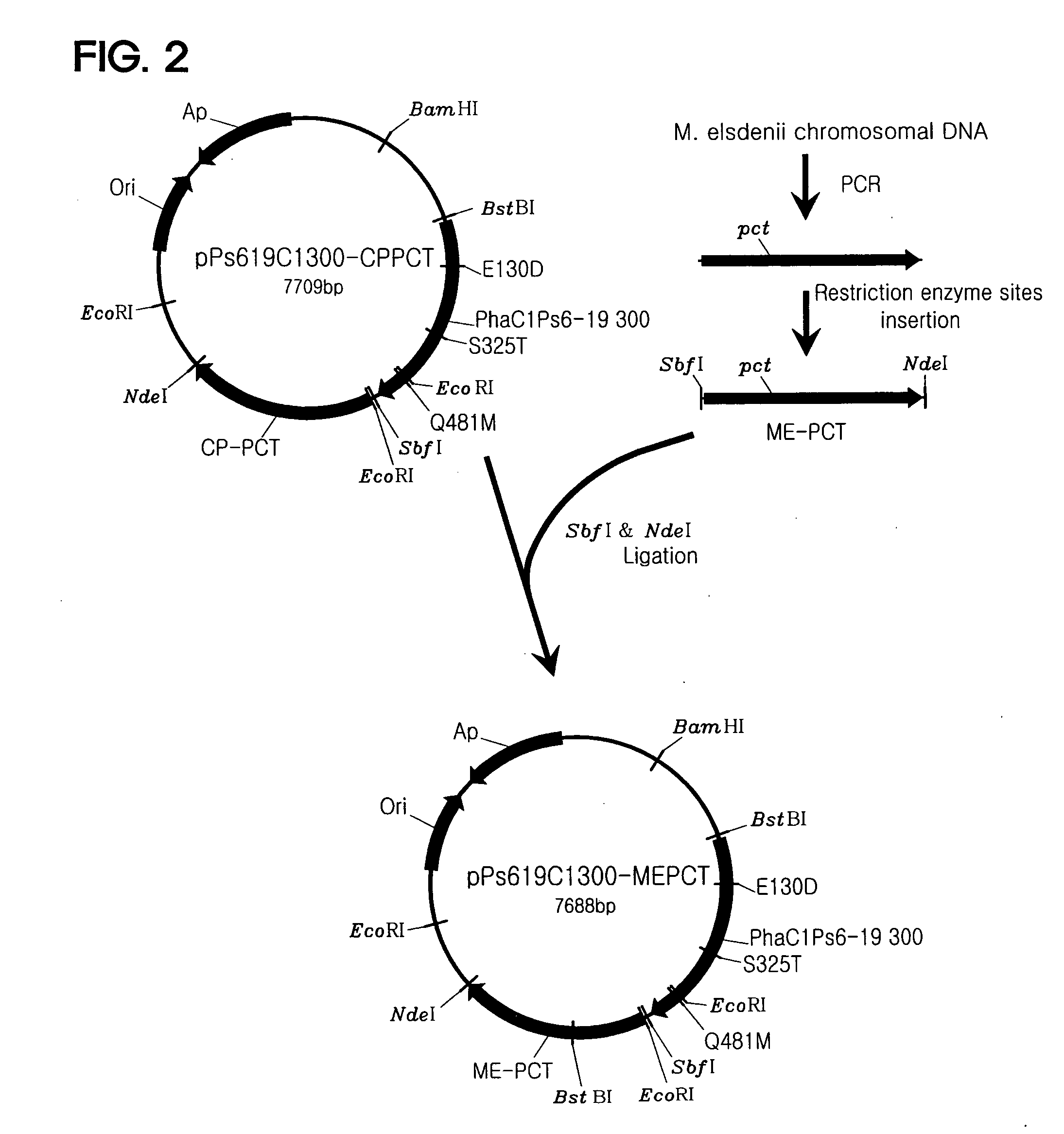Recombinant microorganism having a producing ability of polylactate or its copolymers and method for preparing polyactate or its copolymers using the same
- Summary
- Abstract
- Description
- Claims
- Application Information
AI Technical Summary
Benefits of technology
Problems solved by technology
Method used
Image
Examples
preparation example 1
Cloning of PHA Synthase Gene from Pseudomonas sp. 6-19 and Construction of Expression Vector
[0051]In order to isolate a PHA synthase gene (phaC1Ps6-19) derived from Pseudomonas sp. 6-19 (KCTC 11027BP) used in the invention, total DNA of Pseudomonas sp. 6-19 was extracted. Primers (SEQ ID NOs: 1 and 2) were prepared based on phaC1Ps6-19 sequence (Ae-jin Song, Master's Thesis, Department of Chemical and Biomolecular Engineering, KAIST, 2004), and polymerase chain reaction (PCR) was performed with the primers, thereby obtaining phaC1Ps6-19.
(SEQ ID NO: 1)5′-GAG AGA CAA TCA AAT CAT GAG TAA CAA GAG TAACG-3′(SEQ ID NO: 2)5′-CAC TCA TGC AAG CGT CAC CGT TCG TGC ACG TAC-3′
[0052]When the PCR product was analyzed by electrophoresis on an agarose gel, a 1.7-kbp gene fragment corresponding to phaC1Ps6-19 gene was identified. In order to express a phaC1Ps6-19 synthase, an operon-type constitutive expression system expressing both a monomer-providing enzyme and a synthase was introduced.
[0053]From ...
preparation example 2
Preparation of Substrate-Specific Variants of PHA Synthase from Pseudomonas sp. 6-19
[0059]Among various kinds of PHA synthases, a Type II PHA synthase is known as a medium-chain-length PHA (MCL-PHA) synthase for polymerizing a substrate having relatively many carbon atoms, and the MCL-PHA synthase is expected to be very applicable to production of PLA copolymers. Although the phaC1 synthase derived from Pseudomonas sp. 61-3 is a Type II PHA synthase, which has a high homology with the phaC1Ps6-19 synthase obtained according to the present invention, it was reported that the Type II PHA synthase had a relatively wide range of substrate specificity (Matsusaki et al., J. Bacteriol., 180:6459, 1998), and results of research in a mutation suitable for production of short-chain-length PHA (SCL-PHA) were also reported (Takase et al., Biomacromolecules, 5:480, 2004). Based on the above research, the present inventors found three amino-acid sites affecting SCL activation via amino-acid seque...
preparation example 3
Construction of Recombinant Vector Capable of Expressing Propionyl-CoA Transferase from Clostridium propionicum
[0062]In order to provide lactyl-CoA that is a monomer required for synthesis of PLA or PLA copolymers, a gene of propionyl-CoA transferase from Clostridium propionicum (cp-pct) was used. As is known, cp-pct has toxicity in microorganisms. In general, all recombinant microorganisms die upon addition of an inducer in an isopropyl-β-D-thio-galactoside (IPTG)-inducible expression system using a tac or T7 promoter, which is widely used to express recombinant proteins. For this reason, it was decided that a constitutive expression system in which cp-pct is weakly expressed but continuously expressed with growth of microorganisms is suitable for production of PLA or PLA copolymers. A fragment obtained by performing PCR on a chromosomal DNA of Clostridium propionicum using primers (SEQ ID NOs: 17 and 18) was used as cp-pct. In this case, an NdeI site existing in wild-type cp-pct ...
PUM
 Login to View More
Login to View More Abstract
Description
Claims
Application Information
 Login to View More
Login to View More - R&D
- Intellectual Property
- Life Sciences
- Materials
- Tech Scout
- Unparalleled Data Quality
- Higher Quality Content
- 60% Fewer Hallucinations
Browse by: Latest US Patents, China's latest patents, Technical Efficacy Thesaurus, Application Domain, Technology Topic, Popular Technical Reports.
© 2025 PatSnap. All rights reserved.Legal|Privacy policy|Modern Slavery Act Transparency Statement|Sitemap|About US| Contact US: help@patsnap.com



